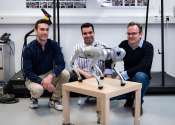Trotting robots reveal emergence of animal gait transitions
A four-legged robot trained with machine learning by EPFL researchers has learned to avoid falls by spontaneously switching between walking, trotting, and pronking—a milestone for roboticists as well as biologists interested ...
Apr 30, 2024
0
90









